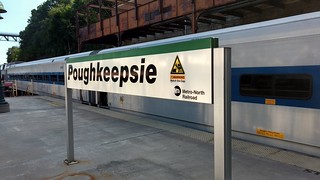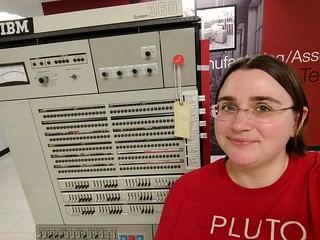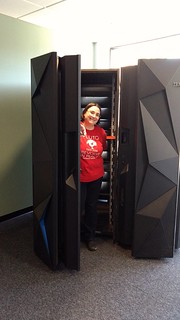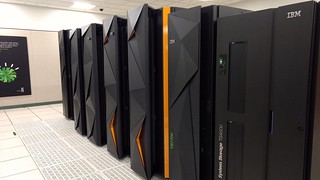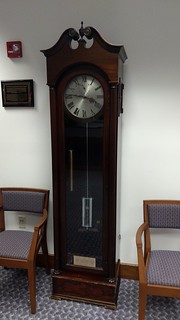Last month I had the pleasure of visiting the mainframe mothership: the IBM offices in Poughkeepsie, New York. A number of folks I work with day to day are based there, there’s a test and assembly facility, and they have a client center where they show off technology, including mainframes!
There’s also an Amtrak station in Poughkeepsie, making the train a solid option coming from the townhouse in Philadelphia. My day started super early as I called a car to take me to the Amtrak station in Trenton. During that ride I learned that my driver was a Philly Linux member long ago, and he happened to mention MJ casually in the conversation. What a small world! We connected on LinkedIn. My 5:43AM train out of Trenton took me to Penn Station in NYC, where I switched to the line that would take me up to Poughkeepsie, putting me in town at 8:45AM, where my colleague Matthew Cousens picked me up.
Matt showed me around the office and let me use his office as a home base for the day as I flitted off to various meetings with folks. The first was with an IBM employee who didn’t actually work with us, my friend and colleague from HPE and OpenStack-land, Matthew Treinish! He lives not too far away and it was nice to have coffee and catch up before he headed back to work.
Around noon I rejoined current colleage Matt and we went to lunch and chatted about how I’m settling into my new role. I’m one of the few people on my team that was hired externally, so it’s always nice to get a chunk of time from team mates as I adjust to IBM culture and get familiar with all the tooling and processes.
After lunch he took me over the the test and assembly facility where they had a little museum set up.
Front and center was an IBM System/360. The s/360 is the granddaddy of all the mainframe stuff I do today and this was the first time I’d ever seen one in person!
But tucked away in the back was something that was perhaps even more impressive from a historical perspective: an early prototype of Herman Hollerith’s tabulator. Anyone familiar with computer history will know that Hollerith’s census machines play a key role in the birth of computing. What I learned from reading Building IBM is that IBM itself traces its roots back to these machines, since Hollerith was the founder of the Tabulating Machine Company, one of the companies that was merged into the Computing-Tabulating-Recording Company in 1911, and renamed IBM in 1924.
First Punched Card Processor
Early prototype built by Herman Hollerith in the late 1880s for the first electrical punched card tabulator.
Back over in the client center, I got to meet some mainframe shells – including one that was just too tempting to pass up a photo of. It actually turned out to be a useful prop when I was at OSCON a couple weeks ago and people asked me how big a mainframe was. “Well, I’ll show you a picture!”
In the early afternoon I met up with Jeff Bisti and Frank De Gilio to record an episode of Terminal Talk. It’s a mainframe-centric podcast, and I’ve been listening to the show since I learned about it a couple months ago when they did an open source on the mainframe edition of the show. It was an honor to be proposed as a guest on the show, especially given how new I am to all this territory, but that was actually the point of me coming in. I’m coming in from a traditional Linux Sysadmin on x86 machines background, so I bring a completely different perspective than the traditional mainframe crowd. The episode was released a few days ago: Elizabeth Joseph – Hyper Protect
After the podcast, it was time to head over to the little raised floor data center they have set up for customer tours. It has all the networking to keep it running, several storage servers, including arrays with spinning and solid state media, and a few robot-driven trap drives. In the fancy bit of the datacenter they have a z14 hooked up to an IBM DS8880 (hybrid storage) that you can poke at, which is the machine Esmeralda Quintana gave a tour of in this video, so it was fun to finally see it in person. I also got to touch the quantum computer (IBM Q)! Which I learned is the only quantum computer in the world running actual external workloads. So cool.
Before I left, I took the advice of Anthony Giorgio and stopped by Ross Mauri’s office to visit a clock.
But not just any clock, in a plaque at the base of it, the history of the clock is told:
INTERNATIONAL TIME RECORDING CO. MASTER CLOCK
This clock was manufactured in Endicott, New York, by the International Time Recording Company, one of the three companies that originally formed IBM. It stood in the anteroom of Thomas J. Watson Sr.’s Office at 50 Broad Street in New York City until 1930, when it was moved to IBM’s new headquarters at 270 Broadway. In 1938 it was moved to the executive floor of 590 Madison Avenue. The clock was moved to the Kenyon House in Poughkeepsie (then the laboratory for IBM’s computer development efforts) in the late 1940’s where it continued in operation until 1994.
This clock is weight driven with a mercury compensated pendulum for precision timekeeping. The weights are wound by an electric motor.
After a couple more meetings, I had to say goodbye to catch my 4:15PM train. The three hour train ride each way made it a pretty long day, and I made this visit a bit on a whim since I was spending time in Philadelphia anyway, but I’m really glad I did. It’s totally worth doing every once in a while.
More photos from my visit here: https://www.flickr.com/photos/pleia2/albums/72157710022012742


